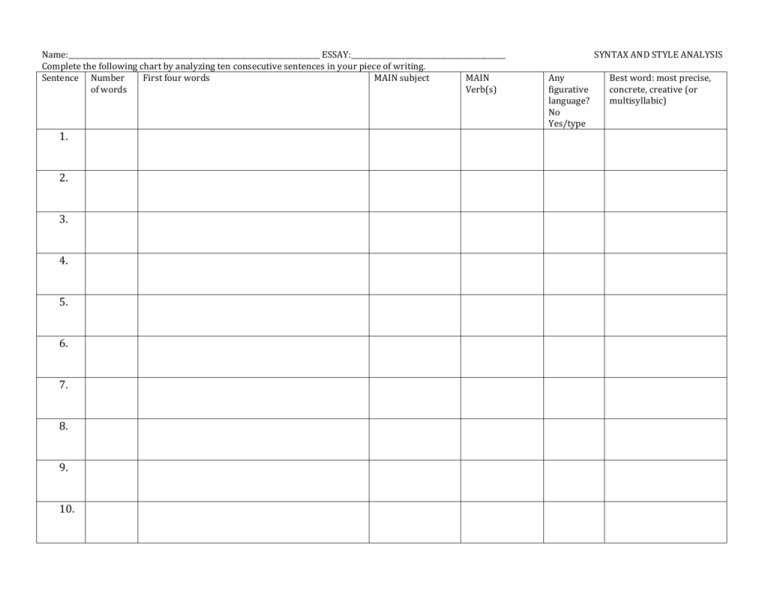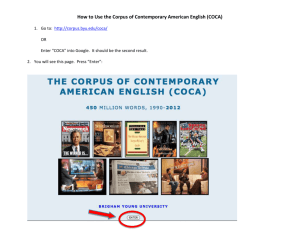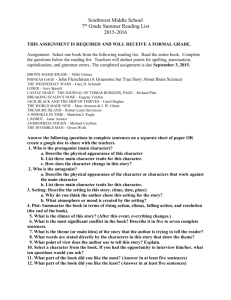Syntax & Style Analysis Worksheet
advertisement

Name:______________________________________________________________________ ESSAY:___________________________________________ Complete the following chart by analyzing ten consecutive sentences in your piece of writing. Sentence Number First four words MAIN subject MAIN of words Verb(s) 1. 2. 3. 4. 5. 6. 7. 8. 9. 10. SYNTAX AND STYLE ANALYSIS Any figurative language? No Yes/type Best word: most precise, concrete, creative (or multisyllabic) Use the chart to answer the following questions: Sentence length: Longest sentence: __________________ words. Shortest sentence: _____________________ words . Average length:________________________ How many sentences have at least five more or at least five fewer words than your average length?__________ Sentence structure: How many times was your main subject located within the first four words of the sentence:__________________ How many times was your main verb located within the first four words of the sentence:___________________ Word choice: How many main verbs were ACTION ___________ LINKING/BEING ____________________ How many times was the subject of your sentence the same as the previous sentence’s subject_ ____________________ How many of your “best” words show precision of thought or creativity: _______How many were obscure or just “big”? ______________ Figurative language: How many examples of figurative language did you include? _____________________ Are they unique and fresh or things you’ve heard before? _________________________________________________________ CONCLUSIONS: (THE IMPORTANT PART) Examine your answers to the previous questions and review the “style tips” handout. Then complete this sentence: To enhance the style of this essay, I should (be specific; include as much as you want) ____________________________________________________________ ______________________________________________________________________________________________________________________________________________________________ ______________________________________________________________________________________________________________________________________________________________ STYLE: SOME GENERAL TIPS 1. The CLARITY of your ideas TO YOUR READER trumps all else. 2. Sentences should vary in length. Reading consecutive sentences of the same length can become dulling or monotonous. Combine ideas where possible to make complex or compound sentences. Mix it up. A short sentence amidst longer sentences can be very effective in drawing the reader’s attention. 3. The beginnings of sentences should vary. Most sentences follow a “Subject + verb + complement” structure, with the subject of the verb often located in the first few words of the sentence. Try starting with A prepositional phrase : Along the road was scattered various debris carelessly discarded by slovenly passersby A participial phrase: Discarded carelessly by slovenly passersby, various debris was scattered along the road. An adverb: Carelessly, the slovenly passersby scattered debris along the road. An appositive phrase: Total slobs, the passersby carelessly discarded various debris along the roadway. Dependent clause: Because they are slovenly, the passersby carelessly discarded various debris along the roadway. 4. Strong and specific action verbs are preferable to linking or being verbs. Sometimes eliminating a being verb requires revamping the entire sentence. What you come up with will be more specific and vivid: Jen is friendly becomes Jen befriends every person she meets. Class is boring becomes The class drags on, seemingly lasting an eternity. 5. Words should be as precise as possible and should help convey the mood of the piece (using “inched” instead of “moved”; using “custard colored” instead of “pale”; using “tower” instead of “building”). Try to create a picture with what you say. This is called using precise and vivid diction. However, avoid unnecessarily “big” or obscure words. 6. Where possible, use parallel structure. Items in a list, consecutive phrases, and compound sentences should contain elements that follow the same pattern. a. I enjoy biking, but I hate running. (NOT: I enjoy biking, but I hate to run) b. Alicia was asked to buy a binder for Spanish, a hole puncher for English, and a stapler for history. (NOT: Alicia was asked to buy a binder for Spanish, a hole puncher for English, and history teacher told her to buy a stapler) c. Although the park’s scenery was beautiful, its odor was nauseating due to the close proximity of the town dump. (NOT: Although the park’s scenery was beautiful, the place stunk because of the close proximity of the town dump)








